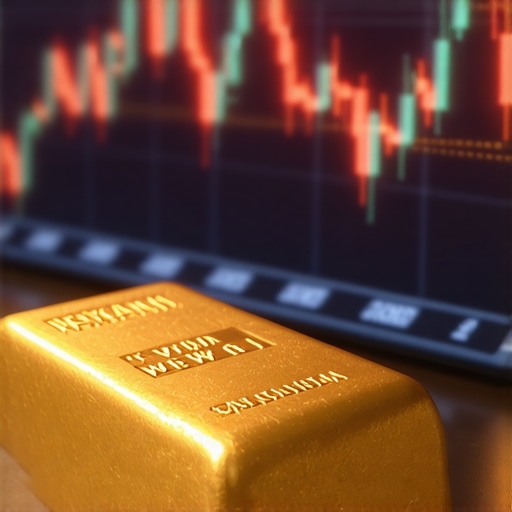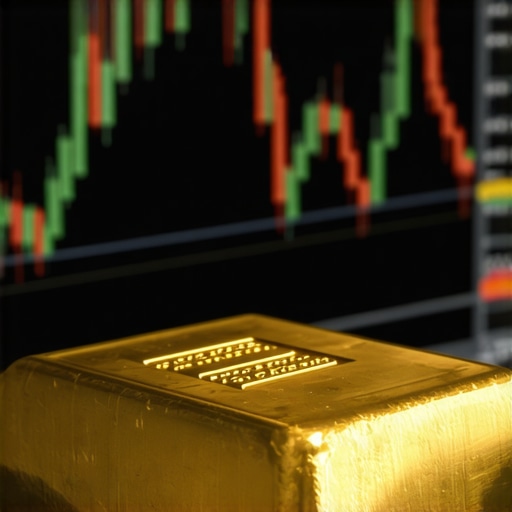Setting the Stage for 2025: Why Gold Remains a Strategic Asset Amid Global Uncertainty
As we advance into 2025, gold continues to captivate investors seeking refuge from geopolitical tensions, inflationary pressures, and volatile currency markets. This precious metal’s intrinsic value is shaped by multifaceted demand and supply dynamics that require nuanced understanding beyond basic price speculation. In this analysis, we dissect the critical forces steering the 2025 gold price forecast, with a focus on global macroeconomic trends, central bank strategies, and evolving investment behaviors that define today’s market landscape.
Unpacking the Complex Drivers Behind the 2025 Gold Price Trajectory
How Do Central Bank Gold Purchases Influence Market Stability and Price Movements?
Central banks play a pivotal role in shaping gold demand and, consequently, price stability. Their strategic accumulation or divestment of gold reserves functions both as a hedge against currency devaluation and a tool of monetary policy diversification. In 2025, increased gold purchases by emerging market central banks, particularly in Asia, signal a nuanced geopolitical hedging strategy that could tighten supply and elevate prices. According to the International Monetary Fund Working Paper on Central Bank Gold Reserves, such trends underscore gold’s re-emergence as a critical reserve asset amid global financial uncertainty.
What Are the Implications of Shifting Global Gold Demand Trends for Investors?
Demand for gold is no longer confined to traditional jewelry and physical holdings but increasingly extends to digital gold products, ETFs, and futures markets. The diversification of demand sources complicates price forecasting but also opens new avenues for strategic investment. Regions like India and China maintain robust physical gold demand driven by cultural factors, while Western markets show growing appetite for gold-backed financial instruments. Investors must navigate these varied demand vectors, balancing physical and digital holdings to optimize portfolio resilience. For deeper insights, see Analyzing Global Gold Demand Trends Impacting Prices 2025.
Strategic Portfolio Positioning: Leveraging Gold Amid Inflation and Economic Volatility
Gold’s status as an inflation hedge remains a cornerstone of long-term investment strategy. Yet, the 2025 landscape demands more sophisticated approaches that incorporate geopolitical risk assessment, currency fluctuations, and alternative asset correlations. Investors are advised to construct diversified portfolios incorporating physical gold, gold ETFs, and mining stocks to maximize returns while mitigating systemic risks. Practical guidance on this approach is available in the comprehensive article on How to Build a Diversified Portfolio with Gold ETFs and Stocks.
What Advanced Gold Trading Techniques Are Essential for Navigating the 2025 Market?
With heightened market volatility, mastering technical analysis, timing gold futures contracts, and understanding market sentiment indicators become indispensable. Sophisticated traders combine macroeconomic data with real-time price signals to execute trades that capitalize on short-term fluctuations without compromising long-term positions. Mastery of these techniques is critical for consistent profitability, as detailed in the guide on Essential Gold Trading Techniques for Beginners and Pros in 2025.
Engage with Our Expert Community
Stay ahead in the evolving gold market by exploring our in-depth analyses and contributing your professional insights on emerging trends and strategies. Visit our expert content hub and join discussions that empower your investment decisions.
Reevaluating Gold’s Role in a Multi-Asset Portfolio: Beyond Traditional Hedging
While gold’s reputation as a safe haven is well-earned, 2025 invites investors to rethink its integration within multi-asset portfolios. Traditional models often allocate gold as a hedge against inflation and currency risk. However, the evolving correlations between gold, equities, bonds, and cryptocurrencies suggest a more dynamic role. Utilizing gold not only as a defensive asset but also as a strategic growth component demands a nuanced understanding of its interplay with other asset classes during varying economic cycles. Investors should leverage quantitative portfolio optimization techniques to identify the optimal gold allocation that balances risk-adjusted returns, especially amid persistent economic uncertainties.
Harnessing Gold ETFs and Mining Stocks: Strategies for Amplified Exposure
Gold exchange-traded funds (ETFs) and mining stocks offer unique pathways to gain leveraged exposure to gold prices with added liquidity and diversification benefits. In 2025, selecting the right ETFs and mining equities requires critical evaluation of expense ratios, underlying asset quality, geopolitical risk of mining operations, and management effectiveness. Combining physical gold holdings with carefully chosen ETFs and stocks can mitigate liquidity constraints and enhance portfolio flexibility. For comprehensive strategies on curating such diversified gold exposure, see How to Build a Diversified Portfolio with Gold ETFs and Stocks.
Advanced Risk Management: Navigating Gold Market Volatility in 2025
Volatility in gold markets, influenced by macroeconomic shocks and speculative trading, necessitates advanced risk management frameworks. Employing tools like options for hedging, stop-loss orders, and volatility forecasting models can help investors protect gains and limit downside risks. Additionally, monitoring central bank policies and geopolitical developments in real time allows for proactive adjustments in gold positions. For traders seeking to sharpen their tactical approach, Essential Gold Trading Techniques for Beginners and Pros in 2025 offers valuable insights into balancing risk and reward effectively.
Can Behavioral Finance Insights Enhance Gold Investment Timing and Decision-Making?
Understanding investor psychology and market sentiment is increasingly crucial in predicting gold price movements. Behavioral finance reveals patterns such as herd behavior, overreaction to news, and sentiment-driven price swings that conventional fundamental analysis might overlook. Integrating sentiment indicators, such as the Commitment of Traders reports and consumer confidence indices, with technical analysis can provide a more holistic framework for timing gold investments. This multidisciplinary approach can improve entry and exit strategies, particularly in volatile market environments.
According to a study published in the Journal of Financial Economics, incorporating behavioral factors significantly enhances the predictive power of commodity price models, underlining the importance of this approach for sophisticated gold investors.
We invite readers to share their experiences and strategies related to behavioral finance applications in gold trading. Engaging with our community can deepen understanding and foster innovative investment approaches.
Decoding Gold’s Correlation Shifts: Navigating Inter-Market Dynamics for Portfolio Optimization
In 2025, the traditional narrative of gold as a static safe haven asset is being challenged by evolving correlations with other financial instruments. Recent data reveal that gold’s relationship with equities, bonds, and even emerging digital assets like cryptocurrencies is increasingly fluid, influenced by economic cycles, monetary policies, and investor sentiment. For instance, during periods of rising inflation expectations combined with tightening monetary policies, gold may decouple from bonds and exhibit increased positive correlation with certain commodities or even equities in specific sectors such as mining or technology.
Deploying advanced quantitative techniques like dynamic conditional correlation (DCC) models allows portfolio managers to capture these time-varying relationships and optimize gold allocations accordingly. By integrating these models, investors can fine-tune their exposure to gold, not merely as a hedge but as a tactical asset that enhances risk-adjusted returns. This nuanced approach supersedes conventional static allocation frameworks and is supported by recent research from the CFA Institute on Dynamic Asset Correlations and Portfolio Management.
How Can Machine Learning Enhance Predictive Accuracy for Gold Price Movements Amid Market Complexity?
Machine learning (ML) techniques, such as ensemble methods and deep neural networks, are increasingly being applied to forecast gold price trajectories with improved precision. These models excel at detecting nonlinear patterns and interactions across a wide array of macroeconomic indicators, sentiment data, and technical signals that traditional econometric models often overlook. For example, incorporating alternative data sources like satellite imagery of mining activity, social media sentiment analysis, and central bank announcement timings can enrich predictive models.
Practical implementation involves training ML algorithms on historical gold price data combined with these diverse inputs to generate probabilistic forecasts that adapt to shifting market regimes. Such approaches enable traders and portfolio managers to anticipate turning points and volatility spikes, thereby optimizing entry and exit points. Industry-leading platforms like Refinitiv and Bloomberg Terminal now integrate AI-powered analytics specifically tailored for commodities, including gold, underscoring this trend toward data-driven decision-making.
Gold Mining Innovations: Technological Advances Shaping Supply and Cost Structures in 2025
Technological innovation within the gold mining sector is another underappreciated factor influencing the 2025 gold price outlook. Enhanced exploration techniques using AI-driven geological surveys and autonomous mining equipment are reducing operational costs and improving yield efficiencies. These advancements can increase the supply responsiveness of gold producers to price signals, potentially moderating price spikes during demand surges.
Moreover, sustainable mining practices are gaining traction, with companies investing in environmentally friendly extraction methods and renewable energy-powered operations. This shift not only aligns with global ESG mandates but also attracts a new cohort of socially-conscious investors who prioritize ethical sourcing. According to the World Gold Council’s recent report on technology and supply dynamics, these trends could subtly reshape the supply curve by 2025 and beyond.

Incorporating Gold’s ESG Dimensions: Navigating Ethical Investment Paradigms and Market Implications
Environmental, Social, and Governance (ESG) considerations are increasingly integral to gold investment decisions. As regulatory frameworks tighten and investor demand for transparency grows, gold producers and funds must demonstrate compliance with rigorous ESG standards. This evolution influences gold’s market perception and may lead to the creation of ESG-labeled gold ETFs and mining equities that cater specifically to this market segment.
Investors face the complex task of evaluating these ESG credentials without compromising financial returns. Advanced ESG scoring methodologies, coupled with blockchain-enabled traceability of gold provenance, are emerging as pivotal tools in this space. Integrating ESG factors into gold investment strategies not only aligns portfolios with sustainability goals but can also mitigate long-term risks associated with regulatory penalties or reputational damage.
For those interested in the intersection of ESG and precious metals, the Morgan Stanley analysis on ESG investing in precious metals offers in-depth perspectives.
What Are the Challenges and Opportunities in Leveraging Blockchain for Gold Supply Chain Transparency?
Blockchain technology promises to revolutionize gold supply chain transparency by providing immutable records of provenance, ownership transfers, and certification compliance. This can significantly reduce counterfeiting risks and enhance investor confidence in the authenticity and ethical sourcing of gold holdings.
However, scaling blockchain solutions across global mining operations entails overcoming interoperability issues, standardization challenges, and the need for robust stakeholder collaboration. Moreover, integrating blockchain data with existing regulatory frameworks and audit processes requires sophisticated technological and legal frameworks.
Despite these hurdles, pioneering initiatives like the Digix project demonstrate viable blockchain implementations in gold tokenization and provenance tracking. Investors and industry participants who engage early with these technologies may unlock new value streams and risk mitigation benefits.
We encourage readers to explore how these cutting-edge innovations can be incorporated into their strategic gold investment frameworks. Sharing your insights on the practical applications and challenges of blockchain in gold markets can enrich our expert community’s discourse.
Integrating AI and Predictive Analytics: The Frontier of Gold Price Forecasting
The application of artificial intelligence (AI) in gold price prediction represents a paradigm shift in commodity market analysis. By leveraging machine learning algorithms that process voluminous datasets—including macroeconomic indicators, geopolitical events, and sentiment analytics—investors can anticipate price inflection points with greater accuracy. Ensemble models and recurrent neural networks (RNNs) capture temporal dependencies and nonlinear relationships, offering predictive agility in the face of market complexity.
How Can Machine Learning Facilitate Real-Time Adaptive Gold Trading Strategies?
Machine learning empowers traders to develop adaptive trading algorithms that recalibrate in real time as new data streams emerge. These AI-driven systems synthesize inputs from satellite monitoring of mining activity, social media sentiment fluctuations, and central bank announcements, dynamically adjusting position sizing and timing. This approach enhances responsiveness to transient market shocks and structural shifts, mitigating drawdowns and optimizing returns. The CFA Institute’s Financial Analysts Journal article on machine learning in commodities offers an authoritative exploration of these methodologies.
ESG Integration: Navigating Ethical Mandates and Market Implications in Gold Investments
Environmental, Social, and Governance (ESG) criteria are reshaping the gold investment landscape, influencing capital flows and corporate behaviors. Investors increasingly demand transparency regarding sustainable mining practices, community engagement, and governance structures. Advanced ESG rating frameworks now incorporate blockchain-based provenance tracking to verify ethical sourcing, reducing reputational and regulatory risks. This evolution compels asset managers to integrate ESG factors into valuation models, potentially redefining risk premiums associated with gold assets.
What Are the Emerging Challenges in Implementing Blockchain for Gold Supply Chain Transparency?
Despite blockchain’s promise to revolutionize gold provenance and certification, widespread adoption contends with interoperability challenges among disparate platforms, legal ambiguities in cross-jurisdictional data governance, and the necessity for multi-stakeholder collaboration across mining, refining, and regulatory entities. Initiatives such as the Digix project showcase practical implementations of tokenized gold assets and immutable supply chain records, yet scaling remains an ongoing challenge. Navigating these complexities is critical for investors aiming to harness blockchain’s full potential in ESG compliance and risk mitigation.
Advanced Portfolio Optimization: Harnessing Dynamic Correlations and Quantitative Techniques
Modern portfolio theory in 2025 transcends static gold allocations, embracing dynamic conditional correlation (DCC) models and machine learning-enhanced risk analytics. These approaches enable investors to capture time-varying interdependencies between gold, equities, bonds, and alternative assets like cryptocurrencies, facilitating tactical allocation shifts aligned with prevailing economic regimes. Quantitative models integrating these variables optimize risk-adjusted returns while preserving capital protection mandates amid heightened global uncertainty.
Engage with our expert analyses and contribute your insights to refine these sophisticated strategies. Harnessing AI, ESG innovations, and blockchain technologies will define the next frontier of gold investment excellence.

Expert Insights & Advanced Considerations
Dynamic Correlation Modeling Transforms Gold Portfolio Allocation
Modern portfolio management increasingly leverages dynamic conditional correlation (DCC) models to capture the evolving relationships between gold, equities, bonds, and alternative assets. These sophisticated quantitative techniques enable investors to adapt gold allocations tactically in response to shifting economic cycles and market regimes, enhancing risk-adjusted returns beyond traditional static hedging paradigms. For investors aiming to optimize multi-asset portfolios, embracing these advanced models is essential in 2025.
Integrating Behavioral Finance Enhances Gold Market Timing
Incorporating behavioral finance insights into gold investment strategies reveals critical market sentiment drivers often overlooked by classical analysis. Recognizing phenomena such as herd behavior, overreactions, and sentiment-driven price swings allows for more nuanced timing of gold entry and exit points. Utilizing sentiment indicators alongside technical and fundamental data provides a holistic framework essential for navigating the heightened volatility characteristic of the 2025 gold market.
Blockchain’s Role in ESG Compliance and Provenance Transparency
Blockchain technology is rapidly becoming a cornerstone for ensuring gold supply chain transparency and ESG compliance. Immutable records of provenance and certification reduce counterfeiting risks and foster investor confidence in ethical sourcing. Despite integration challenges, early adoption of blockchain-based solutions like tokenization projects offers a competitive edge in aligning gold investments with sustainable and regulatory mandates, a vital consideration for forward-looking portfolios.
Machine Learning Empowers Real-Time Adaptive Trading Strategies
Machine learning algorithms, especially ensemble and neural network models, provide cutting-edge predictive capabilities by processing complex, nonlinear interactions among macroeconomic variables, sentiment data, and technical indicators. This enables the development of adaptive trading systems that recalibrate dynamically with incoming data streams, optimizing timing and position sizing to mitigate drawdowns and capitalize on market inflection points in the gold market.
Technological Innovation in Gold Mining Influences Supply Dynamics
Advances in AI-driven exploration, autonomous mining equipment, and sustainable extraction methods are reshaping the cost structures and supply responsiveness of gold producers. These innovations may moderate gold price volatility by enabling more flexible production adjustments, while ESG-aligned operations attract a growing segment of ethically conscious investors. Understanding these supply-side transformations is critical for anticipating future gold market trends in 2025 and beyond.
Curated Expert Resources
- International Monetary Fund Working Paper on Central Bank Gold Reserves: Provides in-depth analysis of how central bank behaviors impact gold demand and market stability globally.
- World Gold Council’s Report on Technology and Supply Dynamics: Offers comprehensive insights into technological advances in gold mining and their implications for supply and cost structures.
- CFA Institute Research on Dynamic Asset Correlations and Machine Learning: Explores advanced quantitative techniques and AI applications that refine portfolio optimization and commodity price forecasting.
- Morgan Stanley Analysis on ESG Investing in Precious Metals: Delivers authoritative perspectives on integrating ESG frameworks within gold investment strategies.
- Digix Project: A pioneering blockchain implementation for tokenized gold assets, enhancing transparency and provenance verification in gold supply chains.
Final Expert Perspective
As the 2025 gold price forecast unfolds amid complex macroeconomic and technological influences, sophisticated investors must transcend traditional paradigms to harness dynamic correlation models, behavioral finance insights, and cutting-edge AI techniques. Coupled with a keen understanding of ESG imperatives and blockchain-enabled transparency, these approaches empower nuanced, resilient gold investment strategies that capitalize on evolving market realities. We encourage readers to deepen their engagement with these advanced frameworks and share their professional insights to collectively refine the future of gold investing. Explore related expert analyses such as 2025 Gold Price Forecast: What Drives Market Value Today and Essential Gold Trading Techniques for Beginners and Pros in 2025 to further enhance your strategic approach.










